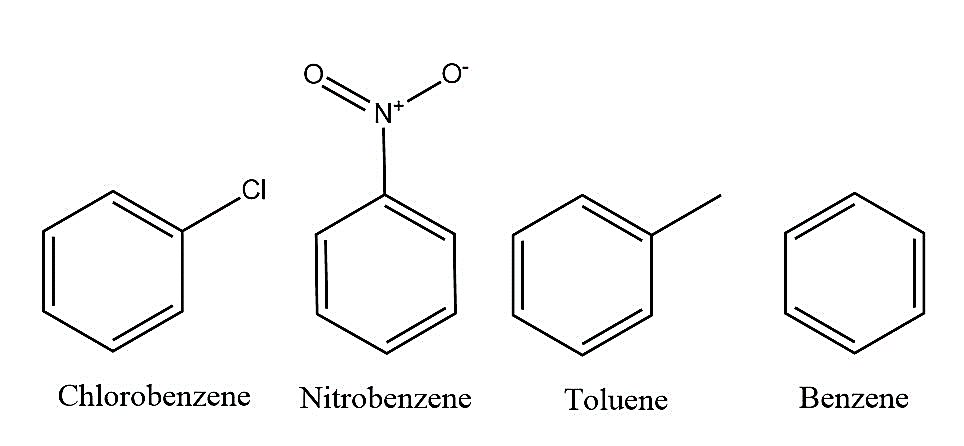Answer
395.4k+ views
Hint: Sulphonation reaction is an electrophilic substitution reaction (ESR). Look at the functional groups present in the given molecules and try to relate their electron-donating or electron-withdrawing effects with electrophilic substitution reactions.
Complete step by step answer:
-Let’s have a look at the options given in the question.

(A) Chlorobenzene- In chlorobenzene, -Cl is the functional group or substituent on the ring. Halogens are highly electronegative so -Cl will withdraw electrons towards itself and deactivate the benzene ring. -Cl is an electron-withdrawing group, so chlorobenzene would not give ESR as easily as benzene.
(B) Nitrobenzene- In nitrobenzene, nitro $-N{{O}_{2}}$ group is the substituent present on the ring. $-N{{O}_{2}}$ is an electron-withdrawing group because nitrogen and oxygen are electronegative atoms. They will attract electrons towards themselves and deactivate the benzene ring. So, nitrobenzene also will not give ESR easily compared to benzene.
(C) Toluene- In toluene, methyl group is the substituent present on the ring. Methyl group shows hyperconjugation effect and so, it is classified as electron-donating group. Methyl group activates the ring and makes it easier to undergo ESR as compared to benzene.
(D) Benzene- Benzene is stabilized with the help of resonance. It has high electron-density and does readily undergo ESR. The presence of electron-donating groups on the ring enhances its ability to undergo ESR. Whereas, the presence of electron-withdrawing groups reduces its ability to undergo ESR.
From the above statements, we can conclude that toluene very easily undergoes sulfonation reactions compared to all other compounds given in the options.
So, the correct answer is “Option C”.
Note: Remember electron-withdrawing groups will always deactivate the ring. Generally, they all are meta-directing but halogens are ortho and para-directing groups. The electron-donating groups are ring activating and ortho and para-directing groups.
Complete step by step answer:
-Let’s have a look at the options given in the question.

(A) Chlorobenzene- In chlorobenzene, -Cl is the functional group or substituent on the ring. Halogens are highly electronegative so -Cl will withdraw electrons towards itself and deactivate the benzene ring. -Cl is an electron-withdrawing group, so chlorobenzene would not give ESR as easily as benzene.
(B) Nitrobenzene- In nitrobenzene, nitro $-N{{O}_{2}}$ group is the substituent present on the ring. $-N{{O}_{2}}$ is an electron-withdrawing group because nitrogen and oxygen are electronegative atoms. They will attract electrons towards themselves and deactivate the benzene ring. So, nitrobenzene also will not give ESR easily compared to benzene.
(C) Toluene- In toluene, methyl group is the substituent present on the ring. Methyl group shows hyperconjugation effect and so, it is classified as electron-donating group. Methyl group activates the ring and makes it easier to undergo ESR as compared to benzene.
(D) Benzene- Benzene is stabilized with the help of resonance. It has high electron-density and does readily undergo ESR. The presence of electron-donating groups on the ring enhances its ability to undergo ESR. Whereas, the presence of electron-withdrawing groups reduces its ability to undergo ESR.
From the above statements, we can conclude that toluene very easily undergoes sulfonation reactions compared to all other compounds given in the options.
So, the correct answer is “Option C”.
Note: Remember electron-withdrawing groups will always deactivate the ring. Generally, they all are meta-directing but halogens are ortho and para-directing groups. The electron-donating groups are ring activating and ortho and para-directing groups.
Recently Updated Pages
Basicity of sulphurous acid and sulphuric acid are

Three beakers labelled as A B and C each containing 25 mL of water were taken A small amount of NaOH anhydrous CuSO4 and NaCl were added to the beakers A B and C respectively It was observed that there was an increase in the temperature of the solutions contained in beakers A and B whereas in case of beaker C the temperature of the solution falls Which one of the following statements isarecorrect i In beakers A and B exothermic process has occurred ii In beakers A and B endothermic process has occurred iii In beaker C exothermic process has occurred iv In beaker C endothermic process has occurred

What is the stopping potential when the metal with class 12 physics JEE_Main

The momentum of a photon is 2 times 10 16gm cmsec Its class 12 physics JEE_Main

How do you arrange NH4 + BF3 H2O C2H2 in increasing class 11 chemistry CBSE

Is H mCT and q mCT the same thing If so which is more class 11 chemistry CBSE

Trending doubts
Difference between Prokaryotic cell and Eukaryotic class 11 biology CBSE

Fill the blanks with the suitable prepositions 1 The class 9 english CBSE

Two charges are placed at a certain distance apart class 12 physics CBSE

Difference Between Plant Cell and Animal Cell

What organs are located on the left side of your body class 11 biology CBSE

Change the following sentences into negative and interrogative class 10 english CBSE

The planet nearest to earth is A Mercury B Venus C class 6 social science CBSE

The Equation xxx + 2 is Satisfied when x is Equal to Class 10 Maths

What is BLO What is the full form of BLO class 8 social science CBSE



